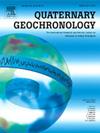Application of multiple-centers ESR dating to middle Pleistocene fluviolacustrine sediments and insights into the dose underestimation from the Ti–H center at high equivalent doses
IF 2.5
2区 地球科学
Q3 GEOGRAPHY, PHYSICAL
引用次数: 0
Abstract
The Ti–H center exhibits rapid and complete optical bleaching properties, meaning it has significant potential for dating applications. However, the equivalent dose of Ti–H centers is underestimated when total doses received by quartz during its geological history reaches a higher level, and there appears to be linked to saturation of the equivalent dose obtained from Ti–H centers. To investigate this phenomenon, a series of samples were analyzed from two sections at Ximachi in Heqing County, China, which have strong Ti–H signals. The sample ages were obtained using the electron spin resonance (ESR) multiple-centers approach, and the reliability of the ages was validated by comparison with optically simulated luminescence (OSL) ages and between different paramagnetic centers. The ESR data demonstrate that the Ti–H centers can provide accurate dose estimates up to 750–950 Gy, with varying degrees of underestimation at high doses. Combined with previously published Ti–H data, it is evident that the upper threshold of the accurate data obtained from Ti–H centers depends on the sample, and may be positively correlated with the Ti–H/(Ti–Li + Ti–H) ratio (option C/D). According to the provenance significance of the Ti–H/(Ti–Li + Ti–H) ratio, we propose that the Ximachi samples have high Ti–H/(Ti–Li + Ti–H) ratios and then equivalent dose saturation values of Ti–H centers, which may be related to the thermal history of the analyzed quartz grains.
将多中心 ESR 测年法应用于中更新世流积岩沉积物,以及对高当量剂量下 Ti-H 中心剂量低估的见解
Ti-H 中心具有快速、完全的光学漂白特性,这意味着它在测年应用方面具有巨大的潜力。然而,当石英在地质历史中接受的总剂量达到较高水平时,Ti-H 中心的等效剂量就会被低估,而且从 Ti-H 中心获得的等效剂量似乎与饱和有关。为了研究这一现象,我们对中国鹤庆县西马池两个具有较强 Ti-H 信号的地段的一系列样品进行了分析。采用电子自旋共振(ESR)多中心方法获得了样品年龄,并通过与光学模拟发光(OSL)年龄以及不同顺磁中心之间的比较验证了年龄的可靠性。ESR 数据表明,Ti-H 中心可提供高达 750-950 Gy 的准确剂量估计值,但在高剂量时会有不同程度的低估。结合以前公布的 Ti-H 数据,可以明显看出,从 Ti-H 中心获得的准确数据的上限取决于样本,并可能与 Ti-H/(Ti-Li + Ti-H) 比率(选项 C/D)正相关。根据Ti-H/(Ti-Li + Ti-H)比值的出处意义,我们认为西马池样品的Ti-H/(Ti-Li + Ti-H)比值较高,那么Ti-H中心的当量剂量饱和值也较高,这可能与所分析的石英颗粒的热历史有关。
本文章由计算机程序翻译,如有差异,请以英文原文为准。
求助全文
约1分钟内获得全文
求助全文
来源期刊

Quaternary Geochronology
地学-地球化学与地球物理
CiteScore
4.40
自引率
22.20%
发文量
130
审稿时长
20 weeks
期刊介绍:
Quaternary Geochronology is an international journal devoted to the publication of the highest-quality, peer-reviewed articles on all aspects of dating methods applicable to the Quaternary Period - the last 2.6 million years of Earth history. Reliable ages are fundamental to place changes in climates, landscapes, flora and fauna - including the evolution and ecological impact of humans - in their correct temporal sequence, and to understand the tempo and mode of geological and biological processes.
 求助内容:
求助内容: 应助结果提醒方式:
应助结果提醒方式:


